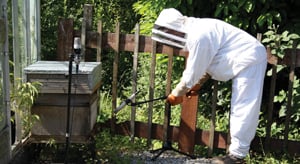Bee sing
People in Swansea don’t usually sing to bees: artists Owen Griffiths and Fern Thomas explain why they did

Who is responsible for the bees? The enormous ecological issue of the threat facing honeybees, and the ecological implications of their loss interested us. How could we, two people (also artists) with little knowledge relating to bees, make a difference?
Working with these questions, we invited composer and friend Mial Watkins to compose a piece of music that could be sung by those who were worried about the bees. From this, the collaborative and participatory artwork ‘For the Bees’, was born.
Mial introduced the phrase ‘a song of will’ which became central to how we understood this project, highlighting the importance of intention. We wondered whether, if people gathered at the bee hives to sing with a shared concern, their singing and the inherent good intention could have a positive effect on the health of the bees. We recorded the sounds of bees in their hives, wanting to reference those sounds as Mial composed the song. (This was our first encounter with a hive of bees and listening to them through the headphones was at once terrifying and thrilling.) The bee choir comprised people who responded to a call-out for those worried about the bees. They sang to two colonies of bees throughout the summer, including a number of public events. This intrigued BBC Radio 4’s science programme Material World, which short-listed ‘For the Bees’ for the Amateur Scientist of the Year award.
Singing to bees, with the hope of creating positive change, works with science in its most traditional sense. Engaging with the world through enquiry and experiment in this way merges the boundaries between science and art, referencing the traditional relationship between these now distinct disciplines, where imagination was key to the way in which people would ask questions about their world. The idea for the project emerged from a necessity, from a need to respond. It felt as if finding a solution to the problems facing the bees needn’t only be left to the scientists, but should be a question we are all capable of considering.
Although the effect of the singing and ‘good intention’ is difficult to measure, offering this idea as a potential solution for the bees presented an image of hope and engagement that spoke about the issue perhaps more keenly than a fact or news headline about yet another creature’s decline. The power of this image of people gathering under a shared cause in front of the actual bees acted as a ‘way in’ for many who had not considered what was happening before. For the participants, and for those who by extension were involved, including friends, family and colleagues, many discussions around bees took place. We both felt as though we had worked with the bees for this time and felt a bit closer to understanding them from where we had first started, forging a life-long connection with these small creatures. In this sense the project questioned our relationship as humans with the other beings that we share this world with, and how just taking the time to watch the bees, or even to sing to them, promotes an understanding which goes a long way towards ensuring their continued existence.
Join the Discussion
You must be logged in to post a comment.